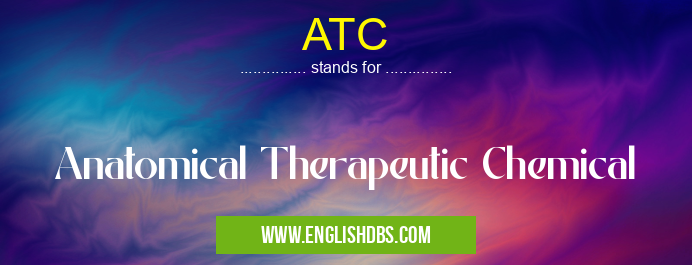What does ATC mean in DRUGS
ATC (Anatomical Therapeutic Chemical) is a system of classifying drugs according to their therapeutic, pharmacological, and chemical properties. It was developed by the World Health Organization (WHO) Collaborating Centre for Drug Statistics Methodology in Oslo, Norway. The ATC system is used by healthcare professionals, regulatory authorities, and researchers worldwide to classify and organize drugs.

ATC meaning in Drugs in Medical
ATC mostly used in an acronym Drugs in Category Medical that means Anatomical Therapeutic Chemical
Shorthand: ATC,
Full Form: Anatomical Therapeutic Chemical
For more information of "Anatomical Therapeutic Chemical", see the section below.
ATC Structure
The ATC code consists of a five-level hierarchical structure:
- First level: Anatomical main group (14 groups, e.g., A: Alimentary tract and metabolism)
- Second level: Therapeutic subgroup (14 subgroups, e.g., A02: Drugs for acid-related disorders)
- Third level: Pharmacological subgroup (67 subgroups, e.g., A02B: Drugs for peptic ulcer and gastro-oesophageal reflux disease)
- Fourth level: Chemical/therapeutic/pharmacological subgroup (350 subgroups, e.g., A02BA: H2-receptor antagonists)
- Fifth level: Chemical substance (e.g., A02BA01: Ranitidine)
Benefits of ATC
- Provides a standardized framework for classifying and organizing drugs
- Facilitates communication and exchange of information about drugs
- Supports rational drug use and medication safety
- Enhances clinical research and drug development
- Facilitates drug monitoring and surveillance
Limitations of ATC
- Can be complex and challenging to understand
- May not fully capture the therapeutic or pharmacological characteristics of some drugs
- Can be difficult to apply to new or emerging drugs
Essential Questions and Answers on Anatomical Therapeutic Chemical in "MEDICAL»DRUGS"
What is the Anatomical Therapeutic Chemical (ATC) Classification System?
The ATC Classification System is a hierarchical coding system that classifies drugs based on their therapeutic, pharmacological, and chemical properties. It is widely used for drug monitoring, research, and drug development.
What is the purpose of the ATC Classification System?
The ATC Classification System aims to:
- Facilitate communication among healthcare professionals
- Classify drugs in a standardized manner
- Provide a common language for drug information
- Support pharmacovigilance and drug utilization studies.
How is the ATC Classification System structured?
The ATC Classification System has five levels:
- Level 1: Anatomical Main Group
- Level 2: Therapeutic Subgroup
- Level 3: Pharmacological Subgroup
- Level 4: Chemical Subgroup
- Level 5: Chemical Substance.
Who developed the ATC Classification System and who maintains it?
The ATC Classification System was developed by the World Health Organization (WHO) Collaborating Centre for Drug Statistics Methodology. It is maintained by the WHO Collaborating Centre for Drug Statistics Methodology in Oslo, Norway.
How can I access the ATC Classification System?
The ATC Classification System is available online on the WHO website. It is also available in various databases and resources, such as Lexi-Comp and IBM Watson Health.
Final Words: ATC is a valuable tool for healthcare professionals and researchers. It provides a systematic and standardized approach to classifying and organizing drugs, facilitating communication, research, and drug safety. While it has certain limitations, ATC remains an essential resource in the field of pharmaceuticals.
ATC also stands for: |
|
| All stands for ATC |
